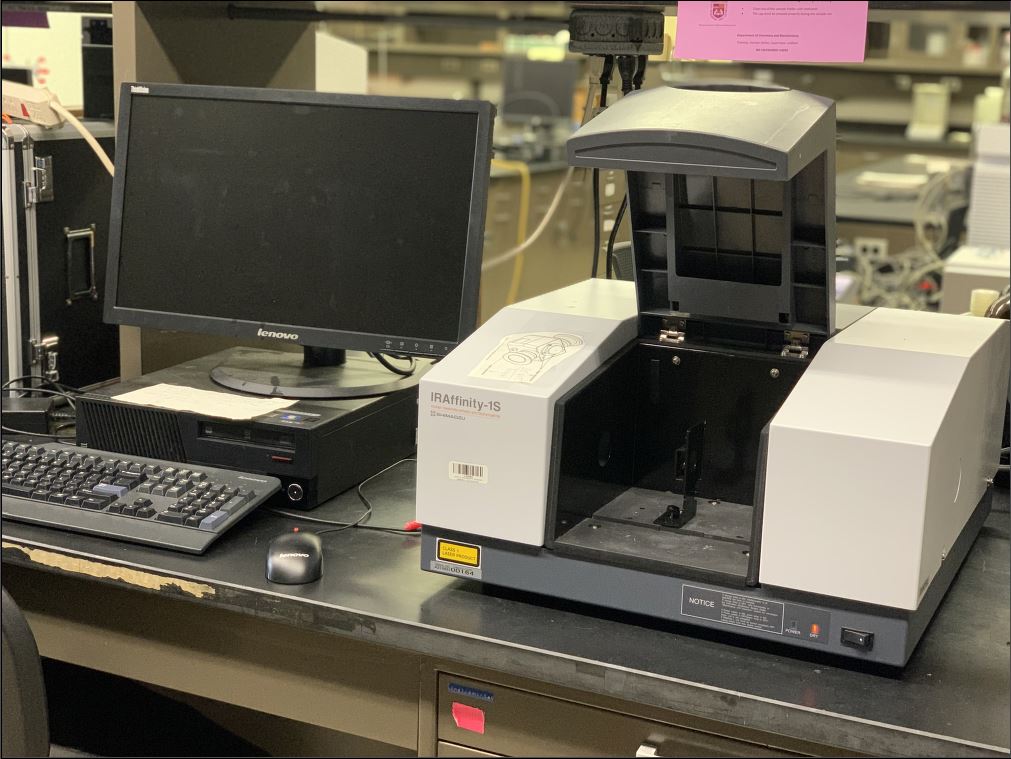Shared Instrumentation Facility
Welcome to the shared Instrumentation Facility at Loyola University Chicago. Within our facility you will find:
Plate Reader: SpectraMax id5 (2024, FH 006)
Used for absorbance, fluorescence, luminescence assays of 6 to 384 well plates. The plate reader has an operating temperature control from 5C to 66C and linear, orbital, or double orbital plate shaking. Capable of florescence polarization, HTRF, and western blot, it has an absorbance accuracy of 0.01 OD. Injector function is also included.
Training (unfilled) Supervisor (unfilled)
Atomic Absorption: ThermoFisher iCE 3500 (2024, FH 314)
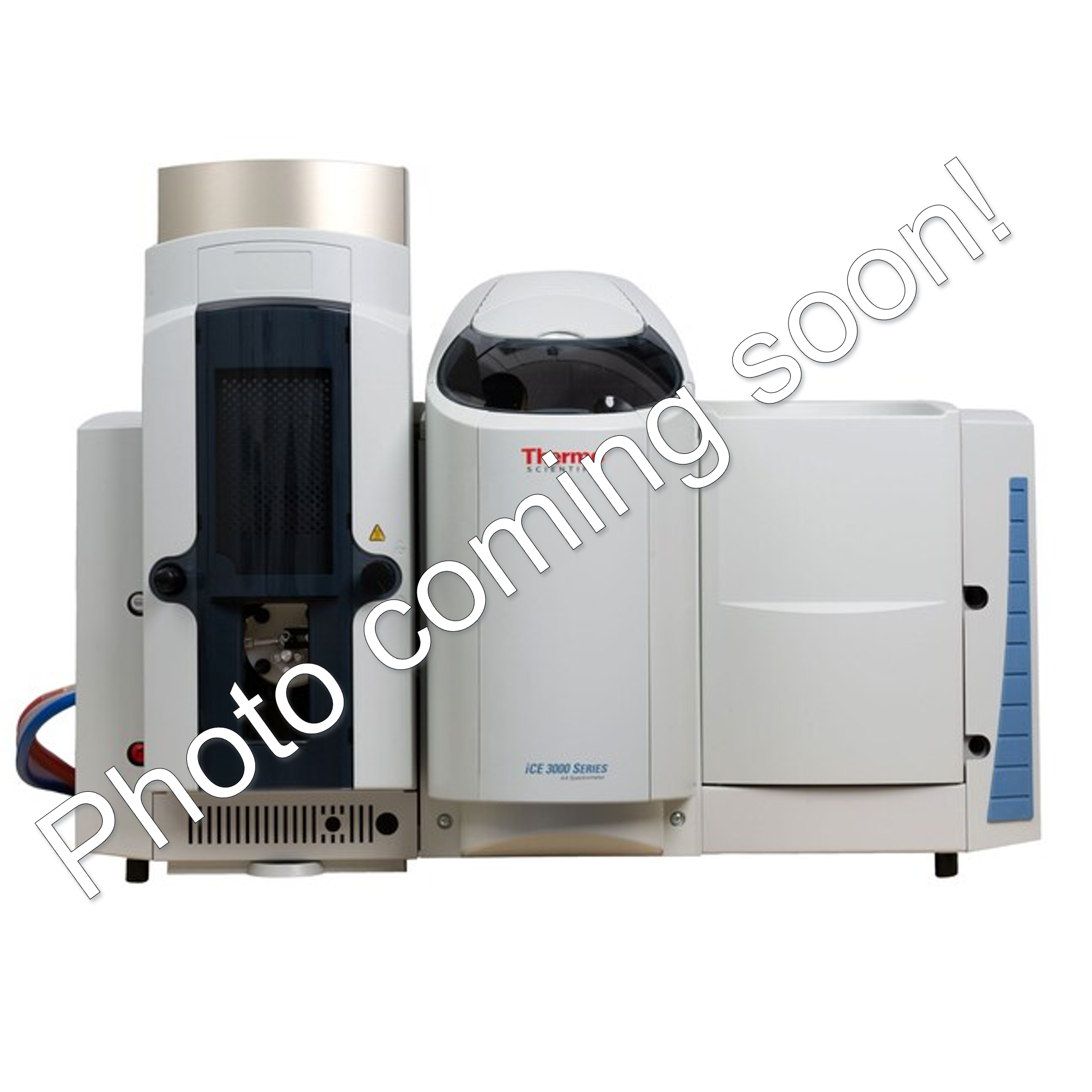
A variety of samples can be detected with applications in environmental analysis, food safety, pharmaceutics, and quality assurance and control. The AA detects low concentration samples (sub ppb) for lead, copper, cadmium, chromium, and zinc with a dual atomizer system. The flame atomizer is ideal to detect in the ppm range and the furnace atomizer is ideal to detect in the ppb range and has standard or Zeeman furnace option. The furnace atomizer workflow can be automated and uses Integrated Graphite Furnace Television to gather information upon sample injection.
Training: (Monika Rasic) Supervisor: Prof. Martina Schmeling
Fluorometer: Jasco FP-8300 (2020, FH 315)
Used for fluorescence and phosphorescence measurements of liquid and solid samples for a broad range of applications in biological, inorganic, materials science and more. The system can scan from 200-900 nm and uses a continuous Xe lamp and red sensitive PMT which offer exceptional sensitivity; also includes internal filter sets to reduce contributions of second order scattering. A single cell Peltier accessory is available that allows stirring and temperature control from 0-100 deg C for kinetics, including temperature ramping for thermal melt studies. A solid sample holder is also available that can measure thin films or powders (with the powder cell holder).
Training: (Claire Baxter) Supervisor: Prof. Joerg Zimmermann
HPLC: Agilent 1260 Infinity II (2019, FH 315)
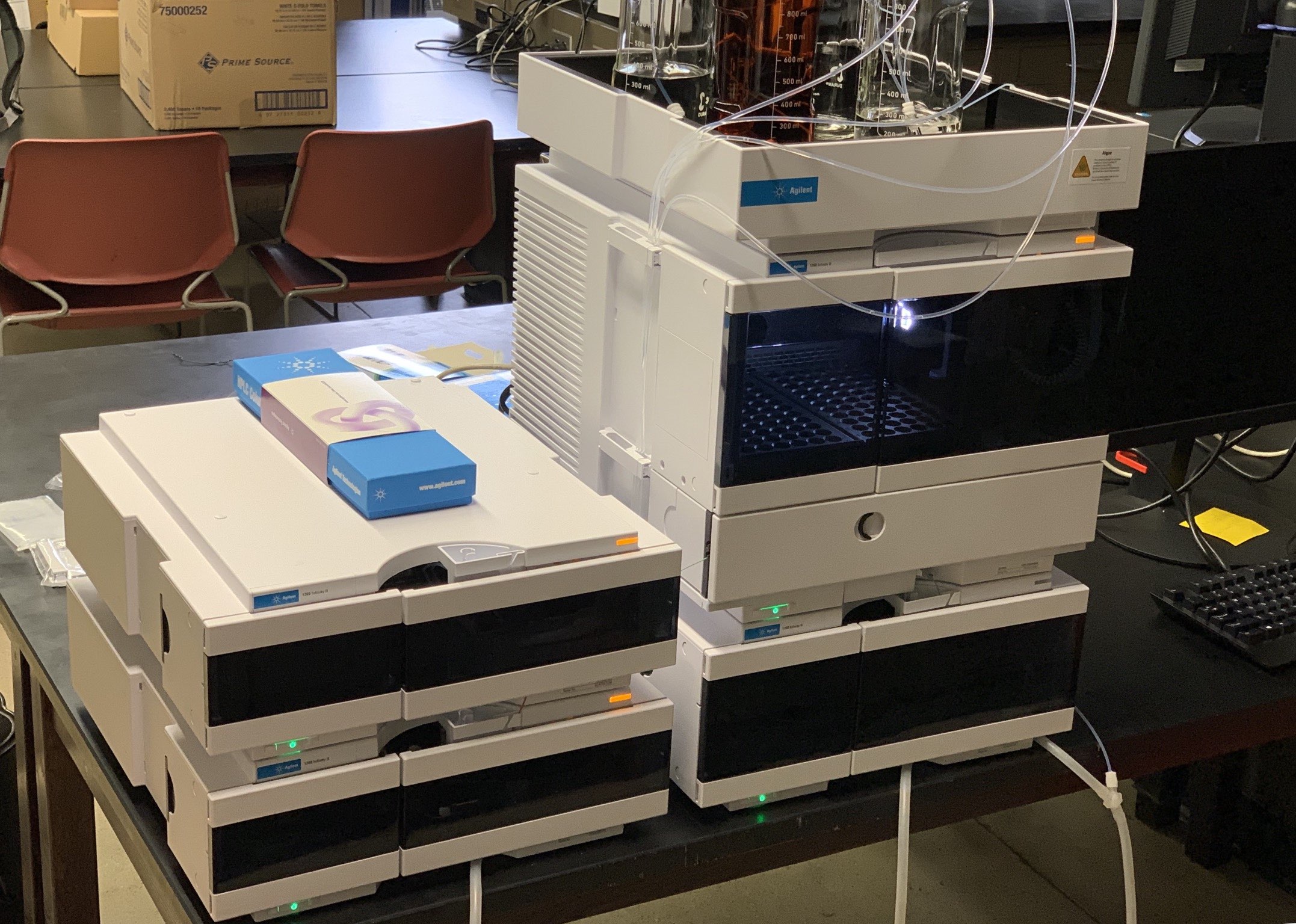
Used for chemical separations and analysis. Contains a diode array and fluorescence detector for spectrochemical analysis with a quaternary pump driving the mobile phase.
Training: (Emma Kelley) Supervisor: Resources Committee
qPCR: QuantStudio3 (2018, FH 002)

Used to amplify, detect, and quantify nucleic acid targets. Applications may include detecting changes in gene expressions as low as 1.5-fold, mutation detection, determining melting point of proteins and peptides, genotyping analysis, or analyzing drug metabolism enzymes. Compatible with 96-well consumables. Contains four channels for the quantification of multiple genes in the same experiment. A heating block with three different temperature zones is also available. Samples can be monitored remotely.
Training: (Nick Kaley) Supervisor: Agnes Pecak
Scanning Electron Microscope: Hitachi SU3500 (2017, FH 315)
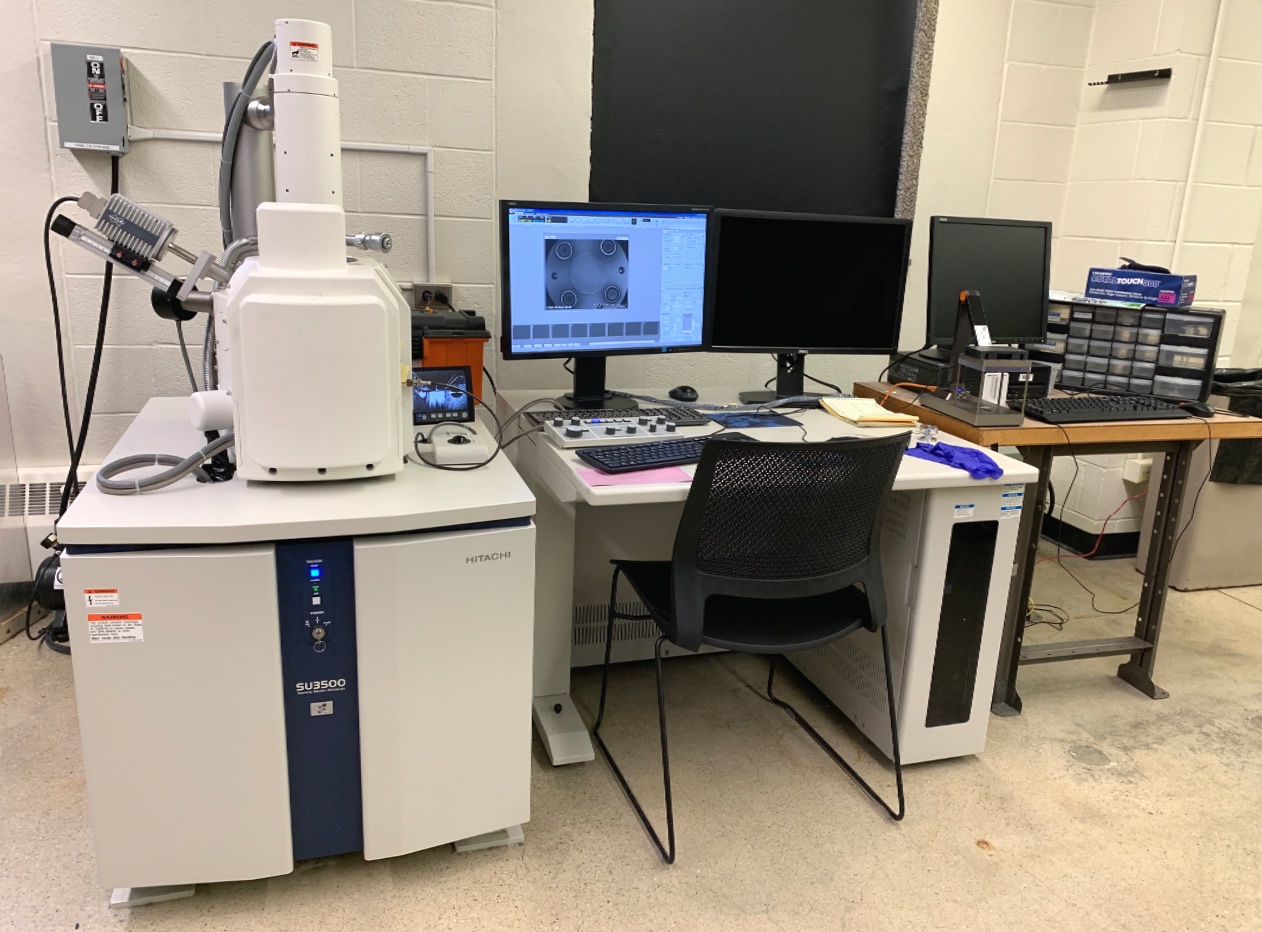
Used for solid morphology determination in the nm to mm range. Variable pressure mode allows for a pressure range of 10-3 to 650 Pascals. Large stage accommodates samples up to 200 mm in diameter. Voltage range of 300 V – 30 kV. Spectral resolution provides 3 nm at 30 kV on high contrast samples. Equipped with a Bruker Quantax EDS system for elemental detection with a backscatter detector. Detects elements Z > 5 on the periodic table. Elemental mapping and composition of samples may be performed.
Training: (Matthew Williams) Supervisor: Prof. Ciszek
GC-MS: Shimadzu-QP2010 SE (2016, FH 314)
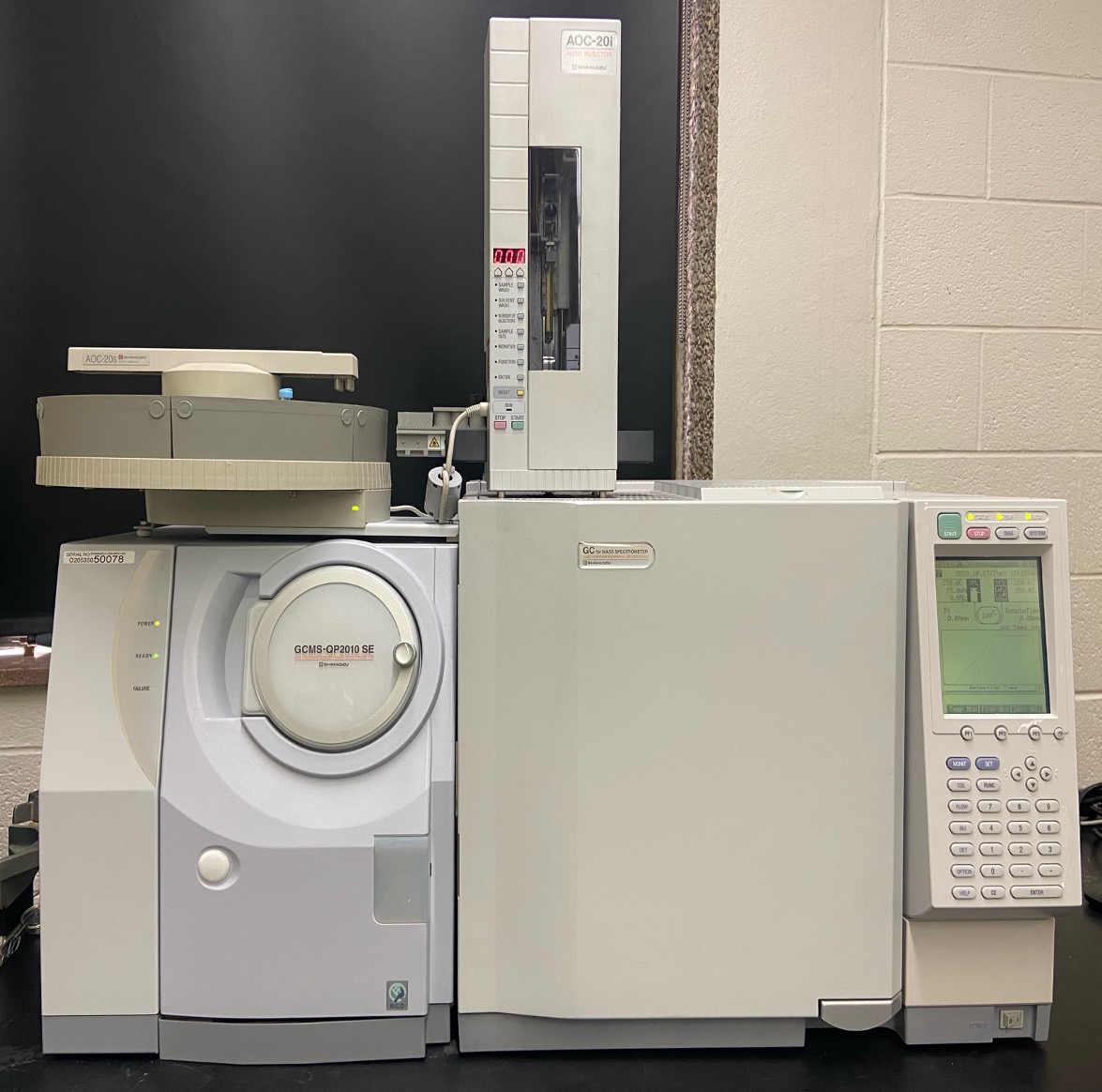
Used to separate molecular species within mixtures coupled with identification via a single quadrupole mass spectrometer. Sample masses can range from 1.5 to 1,000 m/z and be analyzed at a rate up to 10,000 u/sec. A variety of sample introduction techniques can be automated, such as large-volume and temperature-programmable injections, direct insertion probe, headspace, and purge-and-trap. A single turbomolecular pump allows for twin-line configurations.
Training: (Bailey Hanson) Supervisor: Tim Thomas
IR: Shimadzu IRAffinity 1S FT-IR/ATR (2014, FH 315)
Used to analyze vibrational information of the bulk properties of a sample. Equipped with a DTGS detector and a KBr beamsplitter. Optimal for mid-range FT-IR experiments (7800-350 cm-1). The Pike MIRacle attachment provides ATR capabilities in the mid-range region (Cd/Se crystal)
Training: (Richa Khatiwada) Supervisor: Prof. Ciszek
UV-Vis: Shimazdu UV-2450 (2007, FH 315)
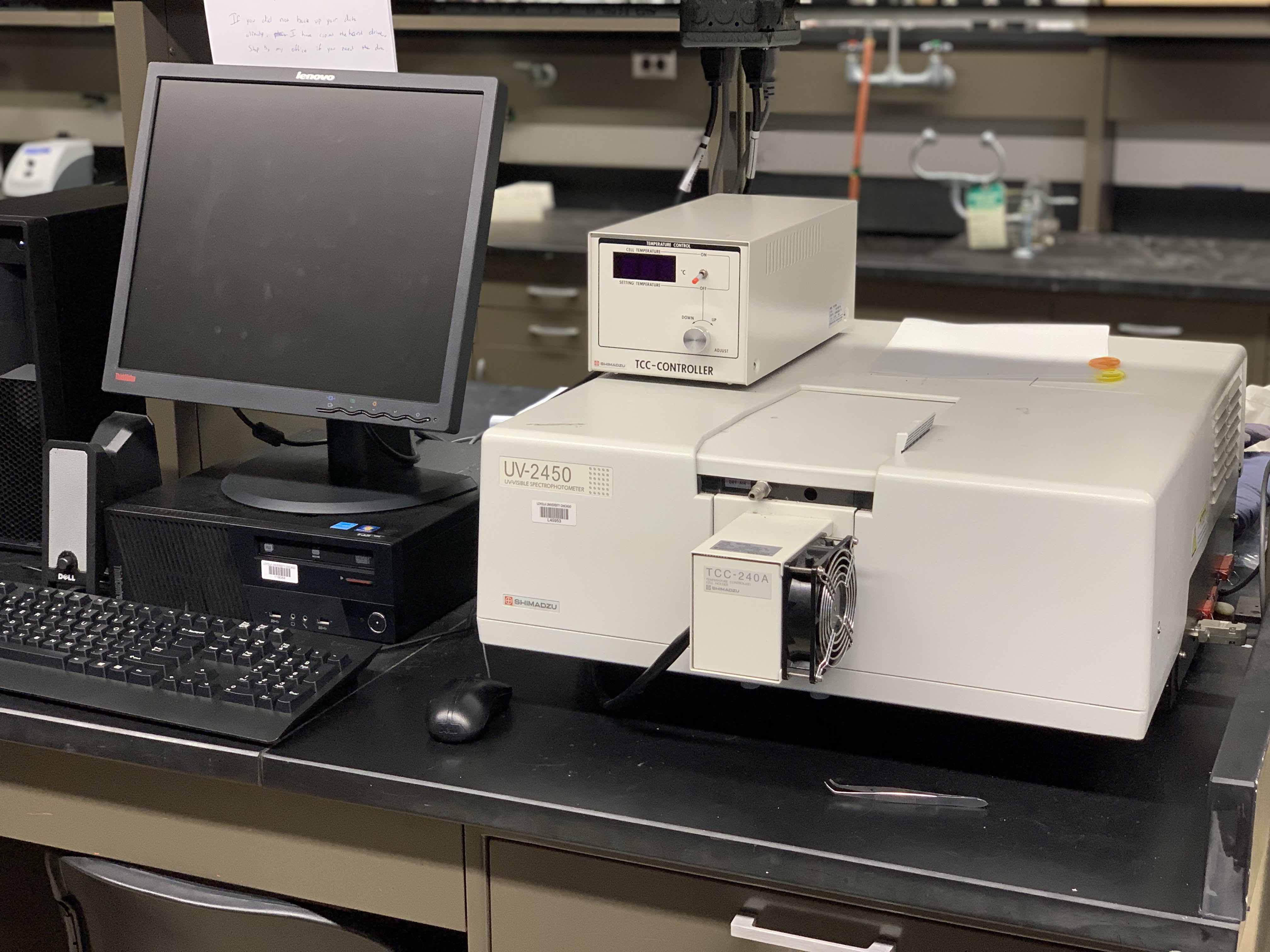
Used to collect absorbance spectra of solutions. Double beam UV-Vis with an effective range of 190 – 900 nm. Powered by dual sources (50 W halogen lamp and a deuterium lamp), has a resolution of 0.1 nm with an accuracy of +/- 0.3 nm. The max cell pathlength is 100 mm. The slit width can be set between 0.1 and 5 nm. The instrument can be used to take several different types of measurements: Spectrum, kinetics, and photometric. The Shimazdu TCC Controller allows for the controlling of temperature in the cell compartment of the instrument in the range of 7-60oC.
Training: (Kevin DePope) Supervisor: Prof. Joerg Zimmermann
Microwave: CEM MARS5 (FH 314)
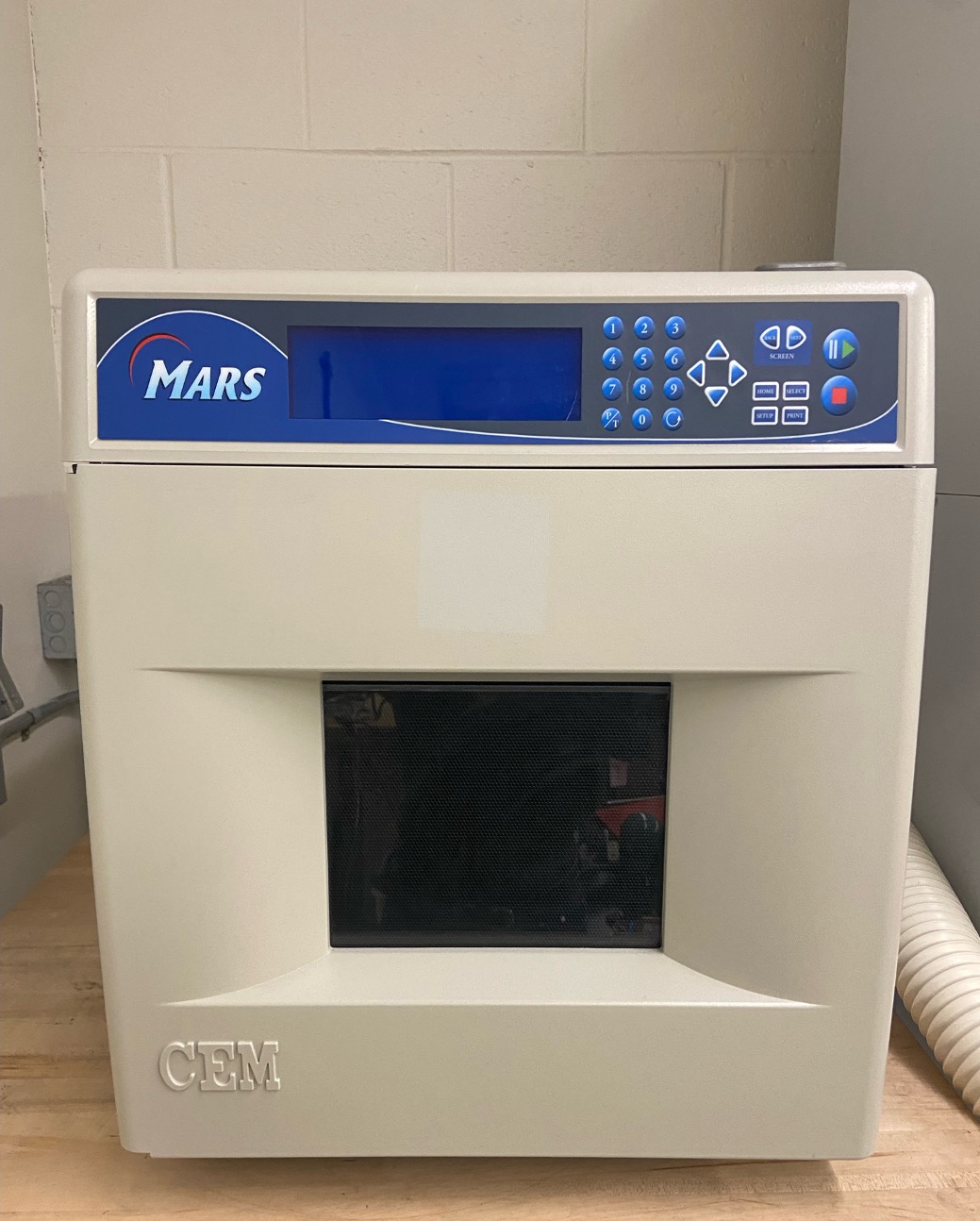
Microwave digestion is used to prepare a variety of samples for trace analysis of metals through digestion or dissolution by mineral acids. Samples include food, plants, tissues, soil and airborne particulates. Analyses methods compatible with MW digestion are atomic absorption spectrometry (AAS), inductively coupled plasma optical emission spectrometry (ICP-OES) and inductively coupled plasma mass spectrometry (ICP-MS). Samples are exposed to microwave energy at 2450 MHz and ~1200 watts at full power, but the settings can be altered for different applications. The apparatus includes a temperature probe and a standard pressure control system to control temperature and pressure, respectively. The sample carousel holds up to 40 samples with MARSXpress Vessel and uses vent and reseal technology without springs for contamination free working.
Training: (unfilled) Supervisor: Prof. Martina Schmeling
Electrochemistry: PGStat 101 (FH 314)
Used to perform numerous standard electrochemical techniques. Functions as a potentiostat and a galvanostat. Software contains standard electrochemical experiments including the study of redox reactions utilizing cyclic voltammetry. Supports between 2-4 electrode connections. +/- 10 V potential range, maximum current of +/- 100 mA, and a current range is 10 mA -10 nA.
Training: (unfilled) Supervisor: unfilled
Raman: Ventana 785 (FH 314)
Used for vibrational analysis of solids. The laser excitation is at 785 nm with a Raman shift range of 250-2000 cm-1. The resolution is 10 cm-1. The slit size is 50 mm. Integration time be set between 22 ms- 4 min. Dynamic range of 17000:1 and signal to noise ratio of 550:1.
Training: (Sara Abuhadba) Supervisor: unfilled
Capillary Electrophoresis: Agilent 7100 (2019, FH 315)
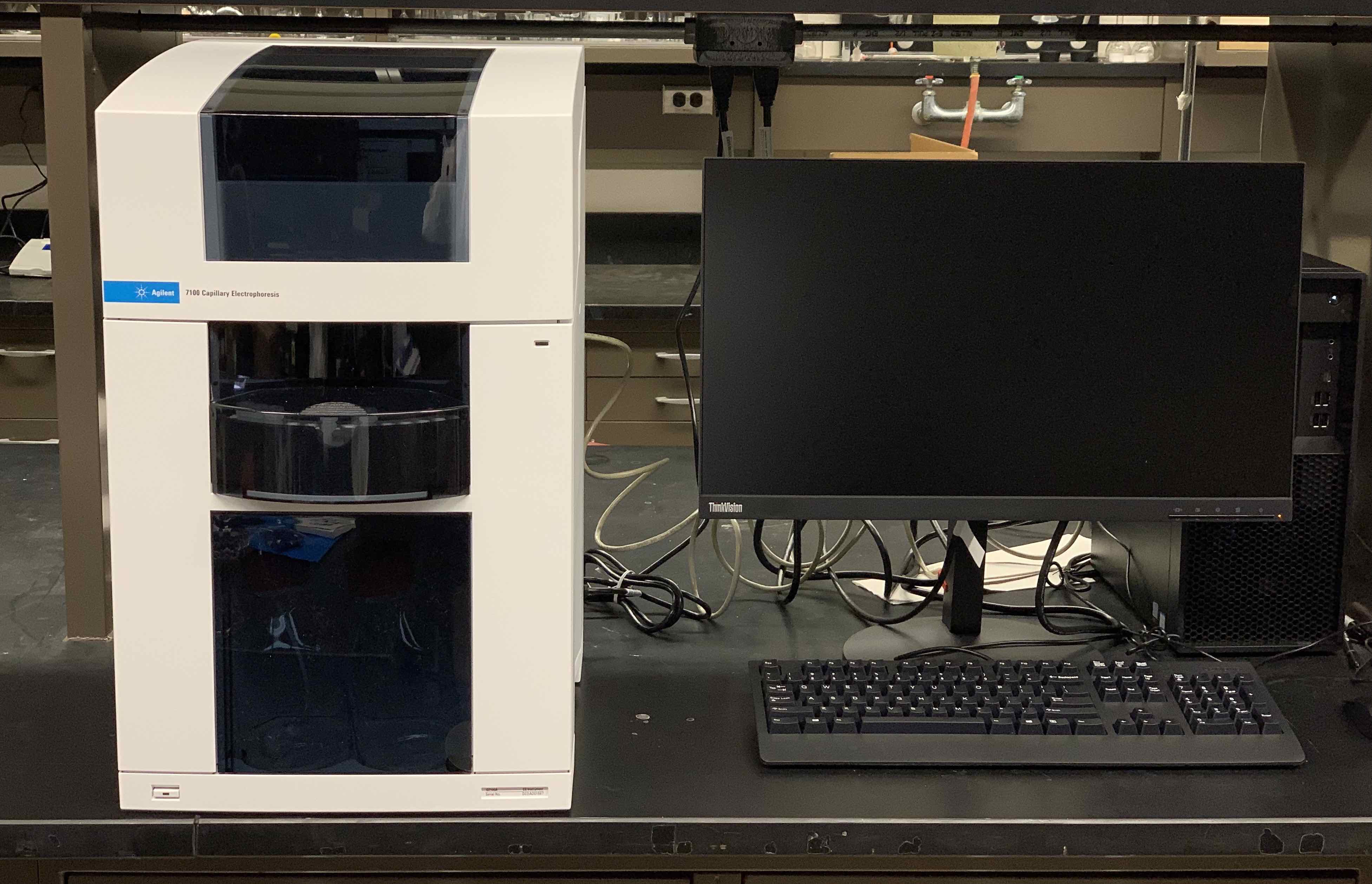
Used to separate ionic compounds, polymers, or proteins based on electrophoretic mobility. Equiped with UV-vis diode array for a detection range of 190-600 nm. Peltier based temperature control from 10 to 60 C. Autosampler allows the acquisition of up to 50 samples in an automated fashion.
This instrument is not heavily scheduled. If seeking to use this instrument, contact the head of the resources committee, Jacob Ciszek
Welcome to the shared Instrumentation Facility at Loyola University Chicago. Within our facility you will find:
Plate Reader: SpectraMax id5 (2024, FH 006)
Used for absorbance, fluorescence, luminescence assays of 6 to 384 well plates. The plate reader has an operating temperature control from 5C to 66C and linear, orbital, or double orbital plate shaking. Capable of florescence polarization, HTRF, and western blot, it has an absorbance accuracy of 0.01 OD. Injector function is also included.
Training (unfilled) Supervisor (unfilled)
Atomic Absorption: ThermoFisher iCE 3500 (2024, FH 314)

A variety of samples can be detected with applications in environmental analysis, food safety, pharmaceutics, and quality assurance and control. The AA detects low concentration samples (sub ppb) for lead, copper, cadmium, chromium, and zinc with a dual atomizer system. The flame atomizer is ideal to detect in the ppm range and the furnace atomizer is ideal to detect in the ppb range and has standard or Zeeman furnace option. The furnace atomizer workflow can be automated and uses Integrated Graphite Furnace Television to gather information upon sample injection.
Training: (Monika Rasic) Supervisor: Prof. Martina Schmeling
Fluorometer: Jasco FP-8300 (2020, FH 315)
Used for fluorescence and phosphorescence measurements of liquid and solid samples for a broad range of applications in biological, inorganic, materials science and more. The system can scan from 200-900 nm and uses a continuous Xe lamp and red sensitive PMT which offer exceptional sensitivity; also includes internal filter sets to reduce contributions of second order scattering. A single cell Peltier accessory is available that allows stirring and temperature control from 0-100 deg C for kinetics, including temperature ramping for thermal melt studies. A solid sample holder is also available that can measure thin films or powders (with the powder cell holder).
Training: (Claire Baxter) Supervisor: Prof. Joerg Zimmermann
HPLC: Agilent 1260 Infinity II (2019, FH 315)

Used for chemical separations and analysis. Contains a diode array and fluorescence detector for spectrochemical analysis with a quaternary pump driving the mobile phase.
Training: (Emma Kelley) Supervisor: Resources Committee
qPCR: QuantStudio3 (2018, FH 002)

Used to amplify, detect, and quantify nucleic acid targets. Applications may include detecting changes in gene expressions as low as 1.5-fold, mutation detection, determining melting point of proteins and peptides, genotyping analysis, or analyzing drug metabolism enzymes. Compatible with 96-well consumables. Contains four channels for the quantification of multiple genes in the same experiment. A heating block with three different temperature zones is also available. Samples can be monitored remotely.
Training: (Nick Kaley) Supervisor: Agnes Pecak
Scanning Electron Microscope: Hitachi SU3500 (2017, FH 315)

Used for solid morphology determination in the nm to mm range. Variable pressure mode allows for a pressure range of 10-3 to 650 Pascals. Large stage accommodates samples up to 200 mm in diameter. Voltage range of 300 V – 30 kV. Spectral resolution provides 3 nm at 30 kV on high contrast samples. Equipped with a Bruker Quantax EDS system for elemental detection with a backscatter detector. Detects elements Z > 5 on the periodic table. Elemental mapping and composition of samples may be performed.
Training: (Matthew Williams) Supervisor: Prof. Ciszek
GC-MS: Shimadzu-QP2010 SE (2016, FH 314)

Used to separate molecular species within mixtures coupled with identification via a single quadrupole mass spectrometer. Sample masses can range from 1.5 to 1,000 m/z and be analyzed at a rate up to 10,000 u/sec. A variety of sample introduction techniques can be automated, such as large-volume and temperature-programmable injections, direct insertion probe, headspace, and purge-and-trap. A single turbomolecular pump allows for twin-line configurations.
Training: (Bailey Hanson) Supervisor: Tim Thomas
IR: Shimadzu IRAffinity 1S FT-IR/ATR (2014, FH 315)
Used to analyze vibrational information of the bulk properties of a sample. Equipped with a DTGS detector and a KBr beamsplitter. Optimal for mid-range FT-IR experiments (7800-350 cm-1). The Pike MIRacle attachment provides ATR capabilities in the mid-range region (Cd/Se crystal)
Training: (Richa Khatiwada) Supervisor: Prof. Ciszek
UV-Vis: Shimazdu UV-2450 (2007, FH 315)

Used to collect absorbance spectra of solutions. Double beam UV-Vis with an effective range of 190 – 900 nm. Powered by dual sources (50 W halogen lamp and a deuterium lamp), has a resolution of 0.1 nm with an accuracy of +/- 0.3 nm. The max cell pathlength is 100 mm. The slit width can be set between 0.1 and 5 nm. The instrument can be used to take several different types of measurements: Spectrum, kinetics, and photometric. The Shimazdu TCC Controller allows for the controlling of temperature in the cell compartment of the instrument in the range of 7-60oC.
Training: (Kevin DePope) Supervisor: Prof. Joerg Zimmermann
Microwave: CEM MARS5 (FH 314)

Microwave digestion is used to prepare a variety of samples for trace analysis of metals through digestion or dissolution by mineral acids. Samples include food, plants, tissues, soil and airborne particulates. Analyses methods compatible with MW digestion are atomic absorption spectrometry (AAS), inductively coupled plasma optical emission spectrometry (ICP-OES) and inductively coupled plasma mass spectrometry (ICP-MS). Samples are exposed to microwave energy at 2450 MHz and ~1200 watts at full power, but the settings can be altered for different applications. The apparatus includes a temperature probe and a standard pressure control system to control temperature and pressure, respectively. The sample carousel holds up to 40 samples with MARSXpress Vessel and uses vent and reseal technology without springs for contamination free working.
Training: (unfilled) Supervisor: Prof. Martina Schmeling
Electrochemistry: PGStat 101 (FH 314)
Used to perform numerous standard electrochemical techniques. Functions as a potentiostat and a galvanostat. Software contains standard electrochemical experiments including the study of redox reactions utilizing cyclic voltammetry. Supports between 2-4 electrode connections. +/- 10 V potential range, maximum current of +/- 100 mA, and a current range is 10 mA -10 nA.
Training: (unfilled) Supervisor: unfilled
Raman: Ventana 785 (FH 314)
Used for vibrational analysis of solids. The laser excitation is at 785 nm with a Raman shift range of 250-2000 cm-1. The resolution is 10 cm-1. The slit size is 50 mm. Integration time be set between 22 ms- 4 min. Dynamic range of 17000:1 and signal to noise ratio of 550:1.
Training: (Sara Abuhadba) Supervisor: unfilled
Capillary Electrophoresis: Agilent 7100 (2019, FH 315)

Used to separate ionic compounds, polymers, or proteins based on electrophoretic mobility. Equiped with UV-vis diode array for a detection range of 190-600 nm. Peltier based temperature control from 10 to 60 C. Autosampler allows the acquisition of up to 50 samples in an automated fashion.
This instrument is not heavily scheduled. If seeking to use this instrument, contact the head of the resources committee, Jacob Ciszek

